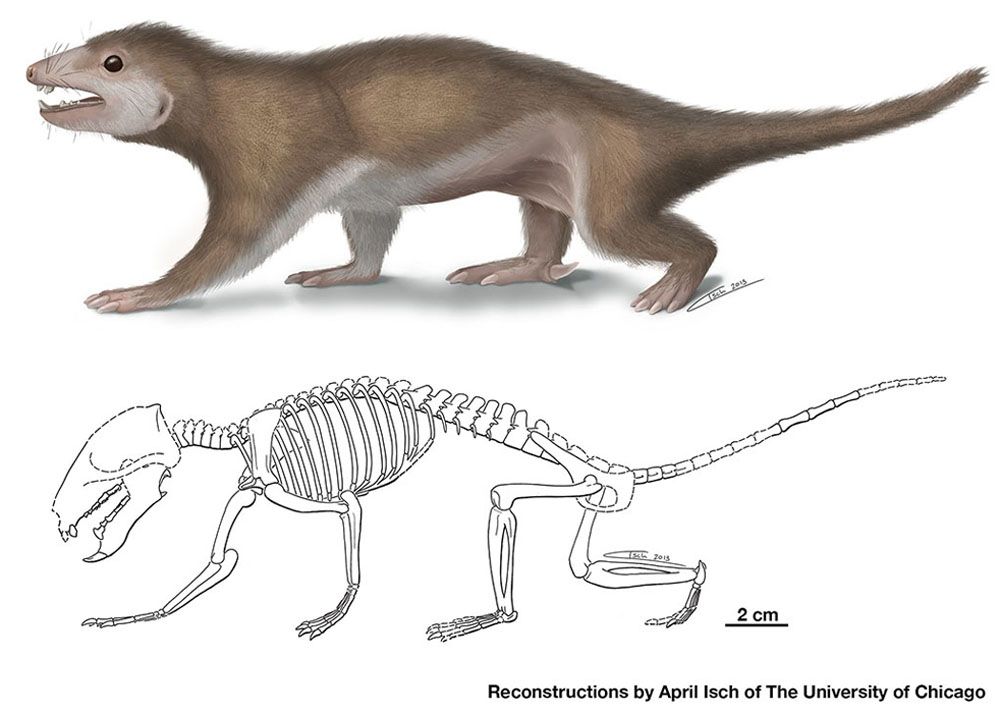Fossil of Ancient Hairy Creature Reveals Clues About Mammal Ancestors

An extremely well-preserved rodentlike fossil recently discovered in China provides some of the best evidence yet for how the earliest human ancestors lived.
Named Megaconus mammaliaformis, the animal closely resembled but predated true mammals, living about 165 million years ago in a humid world dominated by early dinosaurs. It is one of two recently described ancestral mammal fossils that provide a significant leap forward for research in early mammal evolution.
Until now, most knowledge of M. mammaliaformis has been based on isolated teeth remains that suggested that the animals were not highly evolved. But the newly discovered intact skeleton — complete with some of the earliest evidence of hair — shows that these animals were more complex than previously thought, the team reports in the Aug. 8 issue of the journal Nature.
"Research always assumed that these were primitive and not highly specialized, but this animal shows that they were already highly specialized and highly adapted to special feeding strategies," said Thomas Martin, a paleontologist at the University of Bonn in Germany and one of the authors of the paper.
Hair impressions
By closely examining the orientation of the animal's relatively flat teeth in relation to its jaw, the team determined that M. mammaliaformis evolved to grind plants, making it one of the earliest plant eaters in a world dominated by carnivores. [Image Gallery: Fantastic Fossils]
Hair impressions were also found on the fossil. The hair — which appears darker on the animal's back and lighter on its belly — are among the only premammalian hair impressions ever discovered. The hair likely evolved to keep the animals warm, which could indicate that it would otherwise lose heat quickly through a fast metabolism typical of modern rodents, Martin said.
Sign up for the Live Science daily newsletter now
Get the world’s most fascinating discoveries delivered straight to your inbox.
"This is very important because the presence of hair was always postulated, but the direct evidence was never well preserved in fossils," Martin told LiveScience. "This is direct evidence, not just interpolated evidence."
The team calculated the weight of the animal's body based on the length of its limbs, estimating that it weighed roughly half a pound (250 grams) — about the size of a rat. The orientation of its legs in relation to the rest of its body suggests that the animal couldn't hop or climb, but instead maintained a walking gait similar to that of a modern hedgehog or armadillo.
To escape predators, including early dinosaurs and other mammaliaforms (a group that closely resembles but predates true mammals), the animal evolved a spur on the back of its heel that the researchers believe contained poison, similar to modern platypus spurs.
The animal likely roamed humid, junglelike forests full of evergreens and void of colorful flowers that had not yet evolved, Martin said. Fossilized fish surrounding M. mammaliaformis suggest that it died in an ancient lake.
The fossil owes its exceptional preservation to the extremely fine-grained silt, which consists largely of volcanic ash, in which it was found. Surrounding regions in China have yielded a multitude of other important fossils in recent years, including fossils of a similar animal described in the same issue of Nature.
Mammal or not?
The second animal was able to climb trees and has been identified as a mammal, though the authors have classified it within the same broader group to which M. mammaliaformis belonged. This apparent contradiction — that a mammaliaform and a true mammal fall within the same group — has called into question when the first true mammals evolved, but both groups agree that they will only be able to settle this debate upon further analysis of the fossils.
"To me, the most important part is, we know more about the morphology, more about the structure of this extinct group," said Jin Meng, a paleontologist at the American Museum of Natural History in New York and an author of the second paper. "Our knowledge of this extinct group has increased drastically."
Martin and his team also believe both discoveries offer an important step forward in understanding the complexity and diversity of the earliest human ancestors.
"It's very exciting to see that these basic forms can be very highly specialized," said Martin. "The ecomorphological diversity is much higher than anticipated before."
Follow Laura Poppick on Twitter. Follow LiveScience on Twitter, Facebook and Google+. Original article on LiveScience.












